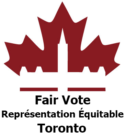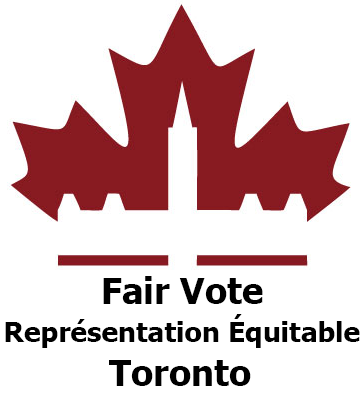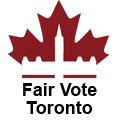Giving people the representation that they vote for, and representing them in proportion to their views is the right thing to do. Here are some of the reasons why most democracies across the world have done the right thing and adopted Proportional Representation.
1. People should get the representation they vote for.
Parliament is supposed to represent its citizens. In order for it to do so, it needs to be an accurate representation of its population. The only way to do this is through adopting the principle of proportional representation.
2. PR Eliminates Artificial Majorities and Artificial Winners.
Every political view in Canada only has a minority of support. Majority governments should not exist in Canada. Adopting PR will eliminate the phenomenon of undemocratic artificial majorities and artificial winners.
This is a good thing because without majorities to compete for, our MPs would be obligated to work in collaboration with each other across party lines in order to govern, or be left out.
Also:
- MPs will be able to think more long-term as single-party majorities would no longer be able to undo the work of the previous government.
- Voters will experience more satisfaction with government, as everyone will know that they are being represented equally in Parliament.
- MPs will have to be more accountable to every voter to be re-elected, and would be less likely to engage in highly partisan politics.
Read about how New Zealand’s former Prime Minister watched as politics changed for the better under PR, or listen to her interview. New Zealand adopted a proportional system known as MMP in 1996. MMP is a riding-based system that looks a lot like how we vote today, and has been recommended for us by the Law Commission of Canada.
3. PR will end the phenomenon of safe ridings, swing ridings and regional sweeps.
Proportional Representation will allow the diversity of voters from every region to elect someone to represent them. The results will then reflect the actual range of support in all regions across Canada. This will end the phenomenon of safe ridings, swing ridings and sweeps of a region by a single party. Parties will then have to campaign to the diversity of voters everywhere, and they will not be able to target swing ridings to win the election.
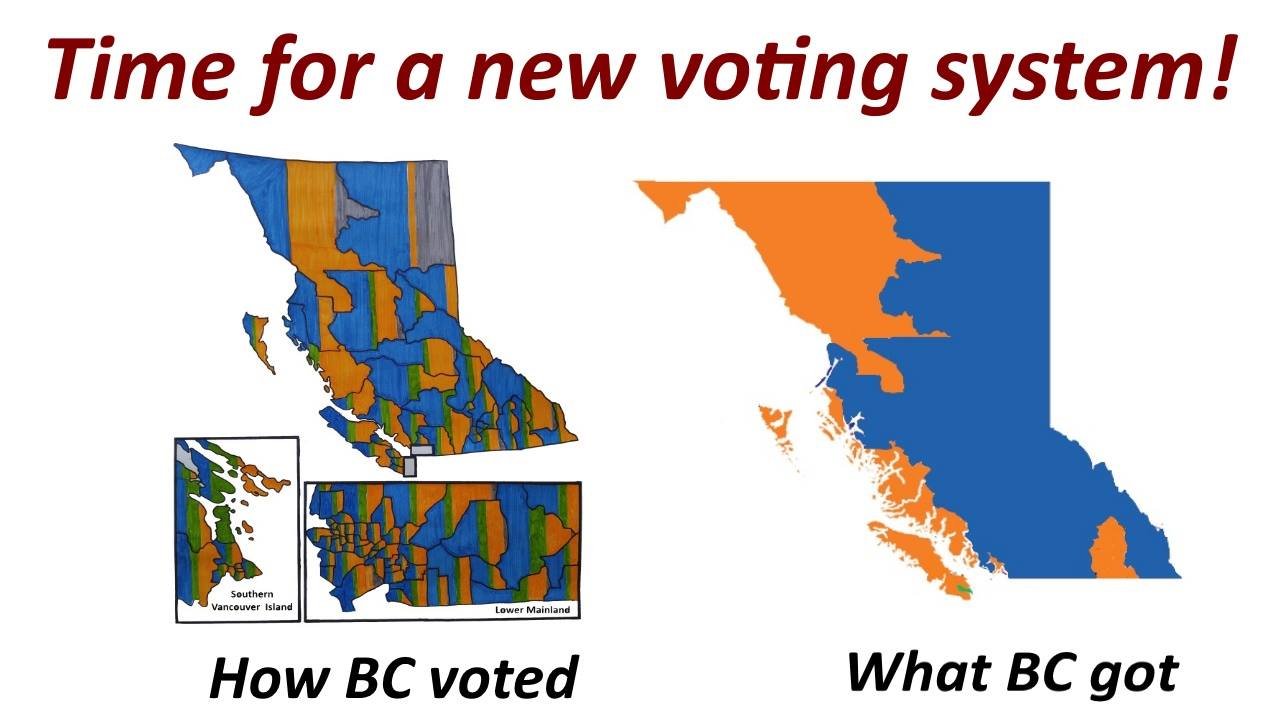
4. PR gives us more choice.
With PR, voters will not only have their local riding MP to represent them, they will also have one or several regional MP’s from other parties representing them. This makes it more likely that everyone will have access to an MP that shares their views instead of just one MP who may not share the views of the majority of their constituents. Learn more about the different PR systems here.
5. PR results in more stable government and fewer elections.
Elections are expensive (up to $500M), and can cause upheaval for citizens. Countries with PR on average have fewer elections. Why?
Under FPTP minority governments are unstable. This is because the lure of artificial majorities creates a highly charged atmosphere of competition with parties constantly vying to win a majority government. This causes parties to try to topple minority governments and trigger elections in the quest for absolute power. This results in more and expensive elections.
Under PR however, minority governments are much more stable. Because proportional representation eliminates the possibility of a majority government, there is no advantage to triggering an early election so it doesn’t happen.
Of the most recent federal elections, there were only two years between elections in 2004, 2006 and 2008. The average number of years between elections in Canada since 1940 is just a little over 3 years. In countries with PR, it is closer to 4 years.
6. PR results in stronger long-term, economically sound policy-making.
Not only does PR bring more stable government and fewer elections, parties are obligated to collaborate in order to govern. This results in more thoughtful and innovative policy, and prevents huge and wasteful policy swings that cause upheaval socially and economically. In fact, it is not surprising that, on average, not only are PR governments more stable, overall corporate taxes are significantly lower in countries with PR. It makes sense that when the government wastes less money it results in lower cost and tax savings.
No matter if it is the economy, social issues, or environmental issues, governments under PR experience more progress because of long-term policy-making. PR encourages collaboration, which means people working across party lines and innovation that creates more thoughtful policy that stands the test of time. The new normal of collaborative government means an end to radical policy swings, and the beginning of more productive long-term thinking that will benefit all policy-making.
7. PR results in a more diverse Parliament reflective of our population.
In the last federal election, only 29% of those elected were women even though 50.4% of us are female. 29% is also lower than the average in countries with proportional systems. Countries that have over 30% women in government have all adopted proportional representation, with the most being Sweden with 43.6%. They also have more women as leaders. Canada briefly had one. New Zealand has had 3 since adopting PR in 1996, in contrast to having absolutely none before PR.
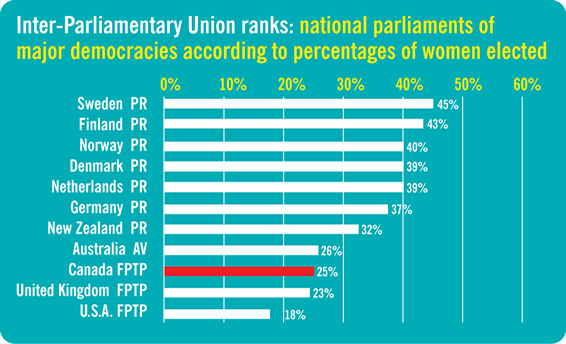
When people are given the ability to vote for and receive the representation they truly want, they choose to elect people more reflective of the diversity of the population. This includes more women, indigenous peoples, and people from different ethnic backgrounds. Parties are also encouraged to put up candidates that attract a diversity of voters.
8. PR keeps unpopular views from attaining disproportionate power.
Canadians are overwhelmingly diverse and responsible voters. With less than 0.4% of Canadians voting for 15 different non-mainstream parties, the possibility of any of these views achieving a seat in Parliament is highly unlikely.
Proportional Representation keeps parties with unpopular views small, too small to have any significance. PR also keeps those with these views from hijacking larger parties and reaching positions of absolute power through artificial majorities. PR keeps the size and influence of all parties predictable, unlike the unpredictability of FPTP. Most importantly, other parties will simply choose not work with parties who have unpopular views because it will not benefit them to upset their voters.
9. PR holds politicians directly accountable to their constituents.
PR will mean that Parties with an artificial majority are accountable to no one, not even their own voters. This has created an atmosphere of mistrust around politics. Add to that the fact that over half of voters cannot even influence the election.
PR will also hold politicians more accountable by eliminating the phenomenon of ‘safe ridings’ and ‘swing ridings’. With votes being equal no matter where you live, parties will no longer be able to win seats by concentrating their campaigns in ridings that will advantage them the most. Parties will have to campaign equally in all ridings in order to drum up voter support. In fact, with PR riding boundaries will actually be of much less importance compared to FPTP, where riding boundaries can have a very significant effect on the overall result.
10. PR results in more voter engagement.
In Canada, voter turnout has dropped from 75% in 1984 to 66% in 2019, and hit a low of 58.8% in 2008. When voters are able to get the representation that they vote for, they feel that their vote will have real power to influence policy-making. This makes them more likely to vote. Countries with proportional voting systems have consistently higher voter turnout, and that is good for democracy.
